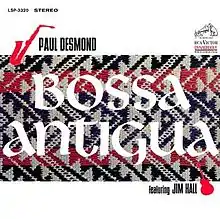Bossa Antigua
Bossa Antigua is an album recorded by American jazz saxophonist Paul Desmond featuring performances recorded in 1964 which were released on the RCA Victor label.[1][2][3] The album title is a word play on bossa nova (in English, "the new thing"), the genre of Brazilian music that inspired the album. "Bossa Antigua" loosely translates in English to "old thing", though "antigua" is a Spanish word rather than Portuguese ("bossa antigo" would be a more accurate Portuguese translation of Desmond's joke).[4] Antigua is also the name an island in the West Indies popular with North American tourists.
| Bossa Antigua | ||||
|---|---|---|---|---|
 | ||||
| Studio album by | ||||
| Released | 1965 | |||
| Recorded | July 28 & 29, 1964, August 20, 1964 and September 8, 1964 RCA Studio A, New York City | |||
| Genre | Jazz | |||
| Length | 58:45 | |||
| Label | RCA Victor LPM 3320 | |||
| Producer | George Avakian | |||
| Paul Desmond chronology | ||||
| ||||
Bossa Antigua and the Jazz Bossa Nova Movement of the early 1960s
From 1962 to 1964, jazz saxophonist Stan Getz popularized the bossa nova style in North America and Europe through a series of albums and single releases. Getz's first hit record in the style was "Desafinado", which became popular in the summer of 1962. In the North American jazz scene, 1962 and 1963 saw the releases of several albums by jazz saxophonists incorporating the style in the wake of Getz's success. Among those albums were Desmond's Take Ten (recorded in the summer of 1963), Zoot Sims' New Beat Bossa Nova: Samba Swings (recorded August 1962), Coleman Hawkins' Desafinado (recorded September 1962), Gene Ammons' Bad! Bossa Nova (recorded September, 1962), Ike Quebec's Soul Samba (recorded October 1962), and Cannonball Adderley's Cannonball's Bossa Nova (recorded December 1962). Getz's biggest bossa nova success was his 1964 recording of the The Girl from Ipanema, which peaked at number five in the U.S. on the Billboard Hot 100 singles chart on July 17 of that year.[5] Desmond recorded the majority of the music released on "Bossa Antigua" between July 28 and September 8, 1964, at the height of the style's U.S. popularity. Desmond continued to incorporate Brazilian rhythms and songs into his music for the rest of his life, recording an album of Brazilian music in 1969 (From the Hot Afternoon), and the songs "Wave", "Manhã de Carnaval", and "Meditation" in 1975 with his final working group for the albums Live and the posthumous Like Someone in Love.
Reception
| Review scores | |
|---|---|
| Source | Rating |
| Allmusic | |
Allmusic awarded the album 4 stars stating " The playing is wonderful throughout, though just missing the full-throttle inspiration of Take Ten".[6]
Track listing
All compositions by Paul Desmond except where noted.
- "Bossa Antigua" – 4:43
- "The Night Has a Thousand Eyes" (Jerry Brainin, Buddy Bernier) – 5:04
- "O Gato" (Jane Herbert) – 4:33
- "Samba Cantina" – 5:38
- "Curacao Doloroso" – 4:30
- "A Ship Without a Sail" (Richard Rodgers, Lorenz Hart) – 6:18
- "Alianca" – 4:29
- "The Girl from East 9th Street" – 6:13
- "The Night Has a Thousand Eyes" [alternate take] (Brainin, Bernier) – 7:18 Bonus track on CD reissue
- "Samba Cepeda" – 5:06 Bonus track on CD reissue
- "O Gato" [alternate take] – 4:53 Bonus track on CD reissue
- Recorded Webster Hall on June 13, 1964 (track 8) at RCA Studio A in New York City on July 28, 1964 (tracks 1, 4 & 10), July 29, 1964 (tracks 2, 6 & 9), August 20, 1964 (tracks 3, 5 & 11), and September 8, 1964 (track 7).
Personnel
- Paul Desmond – alto saxophone
- Jim Hall – guitar
- Gene Cherico (track 8), Eugene Wright (tracks 1-7 & 9-11) – bass
- Connie Kay – drums
References
- Paul Desmond Catalog accessed February 29, 2016
- Paul Desmond Discography Part Three: 1960-1969 Archived 2016-03-24 at the Wayback Machine accessed February 29, 2016
- Berry, S. Jim Hall discography Archived 2016-03-04 at the Wayback Machine accessed February 29, 2016
- Album liner notes Archived March 11, 2015, at the Wayback Machine accessed May 1, 2015
- "Chart History: Astrud Gilberto". Billboard.com. Billboard / MRC Media. Retrieved October 12, 2020.
- Ginell, Richard S.. Bossa Antigua – Review at AllMusic. Retrieved February 29, 2016.